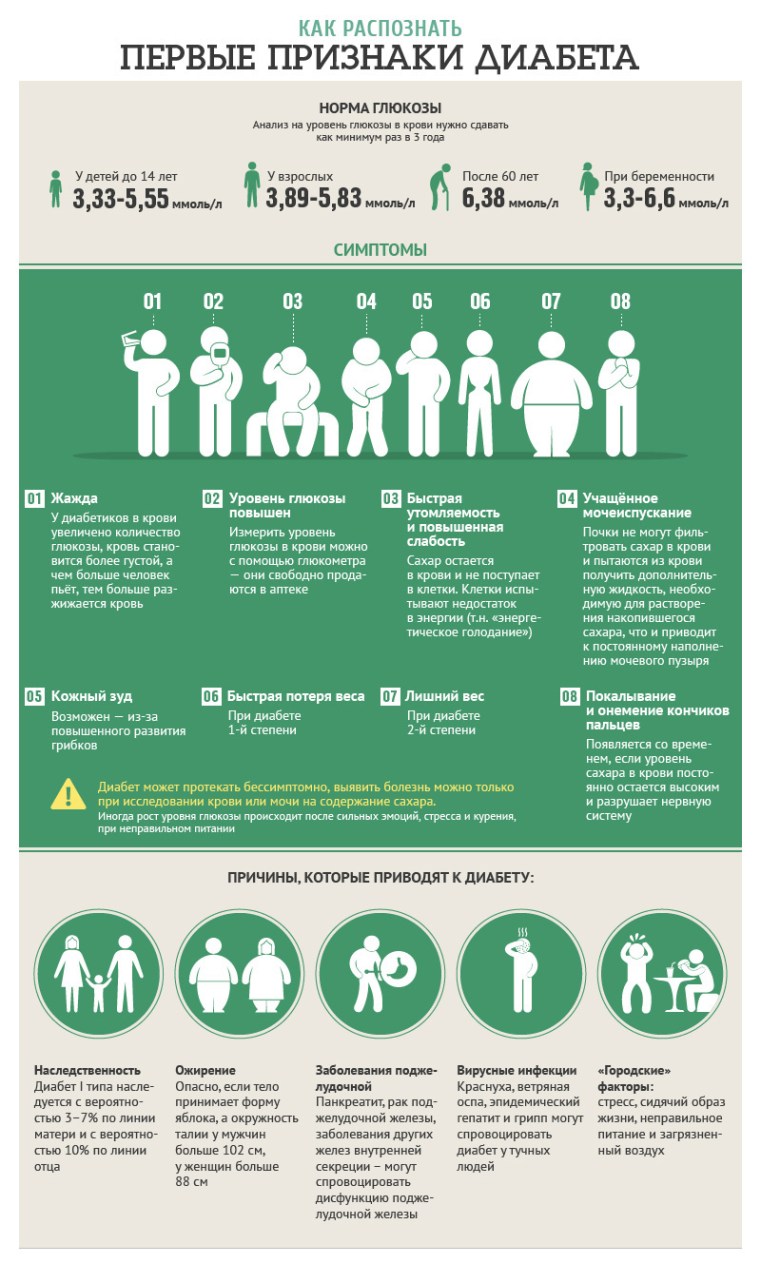Early signs of diabetes that you should not ignore!

Diabetes mellitus type 2 is a very common disease today. Symptoms of diabetes can be easily overlooked.
Diabetes is a very serious disease that causes many dangerous complications, for example, cardiovascular or neurological problems, which is why the sooner a diagnosis is diagnosed, the better.
Proper nutrition, exercise and medicine will help keep diabetes under control and a person who suffers from this disease will be able to continue to live a normal life. Here are some signs of diabetes that can help you in time to recognize it.
How to recognize the first signs of diabetes
Frequent urination
Frequent urge to urinate or urinate at night, can be one of the first signs of diabetes. Kidney, as a rule, it becomes much more difficult to get rid of the excess of glucose in the blood.
Excessive thirst
If you lose more fluid, then the body will do everything to replace it, so this symptom is automatically linked to the previous one and the need to drink increases.
Increased hunger or gluttony
The body constantly wants to eat because of the extreme highs and lows of blood sugar levels. Cells do not receive enough glucose, hence the body begins to crave food.
Dry mouth
Dry mouth, as a rule, attracts bacteria and causes numerous dental problems. In addition, gum disease is a complication of diabetes.
Fatigue
Excess fatigue occurs when the body constantly compensates for the absence of glucose in the cells.
Eye problems
When the blood sugar level is high, it has a negative effect on the eyes and changes the shape of the lens and eyes. Your vision will become blurred. If the sugar level remains high for a long period of time, the changes that occur before your eyes can become permanent and lead to a complete loss of vision.
Bruises, infections, cuts that do not heal
This is due to damage to the blood vessels and is a classic symptom of diabetes. When excessive amounts of sugar are present in the veins and arteries, they become less able to transport blood to a place that must be "repaired" and healed.
Sexual dysfunction
Various sexual problems are also the result of diabetes, because it damages the blood vessels and nerves in the genitals. Men may experience difficulty with erection, and women may experience vaginal dryness. From 35% to 75% of men who suffer from diabetes mellitus face impotence.
In case you experience some of these symptoms, see a doctor, do a blood test and make sure you are ok.
Just try to eat healthy food and in moderation. Also, try not to be nervous and ignore all the bad habits that you have. With age, the risk of developing diabetes increases, so we recommend that you stay physically active and lead a healthy lifestyle.
Clinical signs of diabetes
In the clinical picture of diabetes, it is common to distinguish between two groups of symptoms: primary and secondary.
The main symptoms are:
- Polyuria - increased urinary excretion, caused by an increase in the osmotic pressure of urine due to glucose dissolved in it (normal glucose in the urine is absent). It is manifested by rapid urination, including at night.
- Polydipsia (a constant unquenchable thirst) is caused by significant losses of water with urine and an increase in the osmotic pressure of the blood.
- Polyphagia is a constant insatiable hunger. This symptom is caused by a metabolic disorder in diabetes, namely the inability of cells to absorb and process glucose in the absence of insulin (famine amidst abundance).
- Weight loss (especially characteristic of type 1 diabetes) is a common symptom of diabetes, which develops despite the increased appetite of patients. Losing weight (and even exhaustion) is due to increased catabolism of proteins and fats due to the de-activation of glucose from the energy metabolism of cells.
The main symptoms are most typical for type 1 diabetes. They develop acutely. Patients, as a rule, can accurately name the date or period of their appearance.
Secondary symptoms include low-specific clinical signs that develop slowly over time. These symptoms are typical for diabetes, both 1st and 2nd type:
- Itching of the skin and mucous membranes,
- Dry mouth,
- General muscle weakness,
- headache,
- Inflammatory skin lesions, difficult to treat,
- Impaired vision,
- The presence of acetone in the urine with type 1 diabetes. Acetone is the result of burning fat stores.
Diabetes mellitus (Latin diabetes mellitus) is a group of endocrine diseases associated with impaired glucose uptake and developing as a result of absolute or relative insufficiency of the insulin hormone, resulting in hyperglycemia, a persistent increase in blood glucose. The disease is characterized by a chronic course, as well as a violation of all types of metabolism: carbohydrate, fat, protein, mineral and water-salt. In addition to humans, some animals, such as cats and dogs, also suffer from this disease.
The term "type 1 diabetes mellitus" is applied to the designation of a group of diseases that develop due to the progressive destruction of beta cells of the pancreas, which leads to a deficiency in the synthesis of proinsulin and hyperglycemia, and requires hormone replacement therapy. The term "type 2 diabetes mellitus" refers to a disease that develops in persons with excessive accumulation of adipose tissue that have insulin resistance, as a result of which there is an excessive synthesis of proinsulin, insulin and amylin by beta cells of the pancreas, there is a so-called "relative deficiency". The last revision of the classification of diabetes was made by the American Diabetes Association in January 2010. Since 1999, according to the classification approved by WHO, type 1 diabetes, type 2 diabetes, pregnant women's diabetes and "other specific types of diabetes." Also, the term latent autoimmune diabetes in adults (LADA, "type 1 diabetes") and a number of rarer forms of diabetes mellitus are singled out.
There are a number of classifications of diabetes mellitus on various grounds. Together, they are part of the structure of the diagnosis and allow you to accurately describe the condition of a patient with diabetes.
IDiabetes mellitus type 1 or "juvenile diabetes" , however people of any age can be ill (destruction of B cells leading to the development of absolute lifelong insulin deficiency)
- Autoimmune, including LADA,
- Idiopathic
Diabetes mellitus type 2 (defect of insulin secretion against the background of insulin resistance)
- MODY - genetic defects of B-cell function.
Note: categories: "Persons with normal body weight" and "Persons with overweight" were abolished by WHO in 1999.
IIIOther forms of diabetes:
- Genetic defects (anomalies) of insulin and / or its receptors,
- Diseases of the exocrine part of the pancreas,
- Endocrine diseases (endocrinopathy): Itzenko-Cushing syndrome, acromegaly, diffuse toxic goiter, pheochromocytoma and others,
- Diabetes induced by drugs,
- Diabetes, induced by infections,
- Unusual forms of immune-mediated diabetes,
- Genetic syndromes, combined with diabetes mellitus.
Gestational diabetes mellitus is a pathological condition characterized by hyperglycemia that occurs during pregnancy in some women and usually spontaneously disappears after birth.
Note: should be distinguished from the pregnancy that has arisen in patients with diabetes mellitus.
According to WHO recommendations, the following types of diabetes mellitus are distinguished in pregnant women:
- Type 1 diabetes mellitus detected before pregnancy.
- Diabetes mellitus type 2, revealed before pregnancy.
- Diabetes mellitus of pregnant women - this term combines any violations of glucose tolerance that occurred during pregnancy [17].
Via wiki & fithacker.ru




Comments
When commenting on, remember that the content and tone of your message can hurt the feelings of real people, show respect and tolerance to your interlocutors even if you do not share their opinion, your behavior in the conditions of freedom of expression and anonymity provided by the Internet, changes Not only virtual, but also the real world. All comments are hidden from the index, spam is controlled.